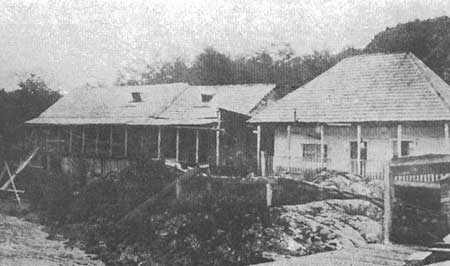Patagonia Bookshelf
Notes on the creation of the Baker estancia, Aisén Region (1916-1928)
by Stephen Lucas Bridges, manager

Family Origins
Stephen Lucas Bridges was born in 1874 at Ushuaia, Tierra del Fuego. He was the 3rd child of the Anglican missionary Thomas Bridges, who had settled there to carry Christianity to the native peoples of the Beagle Channel. Retiring from missionary work in 1887, Thomas established himself at Harberton on land granted by the Argentine government. Here Lucas learned about ranching first-hand.
These were boom times for Patagonian sheep farmers. The family business prospered, extending in 1901/02 to Estancia Viamonte, on the Atlantic side of the island. Lucas's sister Bertha married Percival Reynolds, who became a partner in the family business.
Hobbs y Cía. Chilean concession
In 1916 the Bridges family was invited to take a shareholding in Ernest Hobbs' company, which intended to establish a sheep ranch on a 500,000 hectare Chilean government concession in the valley of the River Baker, 600 km to the north of Punta Arenas (in the Aysén region). A previous ranching venture in this area had come to a disastrous end, when around seventy workmen died.
This was undeveloped land, devoid of all infrastructure, and almost completely unpopulated. Hemmed in by mountain barriers to north and south, it was isolated from the rest of Chile, being accessible overland only from Argentine territory. One of the government's objectives was to create a new route to the interior from the Pacific coast.
Lucas Bridges travelled to the region, and after inspecting the area under consideration, recommended acceptance of the offer of participation. But by 1921, the new company also found itself in difficulties, having consumed all its capital and incurred heavy debts.
An Arduous Enterprise
Lucas returned urgently from Africa, where the Bridges family had started a new ranching venture. After a lengthy visit to the Baker project, and firmly convinced that it was viable, he persuaded the other shareholders to continue with the endeavour, offering himself as on-site manager. For more than 20 years he was the driving force of the enterprise, contending with, and largely overcoming enormous difficulties: technical challenges, natural phenomena and competition for land. It was not until after 1933 that the company entered a period of comparative calm and prosperity, having giving up half of the land concession.
In this web-site we present two short papers, (Memories and Synopsis, both in Spanish), in which Bridges describes the early Baker years, mentioning numerous incidents from his first-hand experience. A natural "go-getter", he was unable to admit defeat, and willing to "roll up his sleeves" when the occasion demanded - in short, an exceptional person.
Some significant events covered in these pieces are as follows:
1916 murder of manager Charles
Wood near Entrada Baker
192x loss of boat "Ian Lucas", presumably by river surge
1928 end-of-contract inspection visit by Chilean government
1931 armed attack by group of Alacaluf natives led by a mestizo, 3 of whom
were killed
1932 murder of German
employee at Bajo Pisagua, and destruction of installations
by arson
1933 theft of boat "Ian Lucas II"
Final Years
Lucas Bridges continued to manage the Baker property until past 70 years of age when, suffering heart trouble, he moved to Buenos Aires. It was during his convalescence that he wrote his classic book "Uttermost part of the earth", a fascinating account of his early years in Tierra del Fuego. He died in Buenos Aires in 1949 at the age of 74.
There was not to be a sequel describing his experiences on the Baker - only these two short papers written in Spanish, the one somewhat repetitive of the other. Still, we can be grateful that they lift at least a corner of that curtain of mystery which still surrounds this remote corner of southern Patagonia.